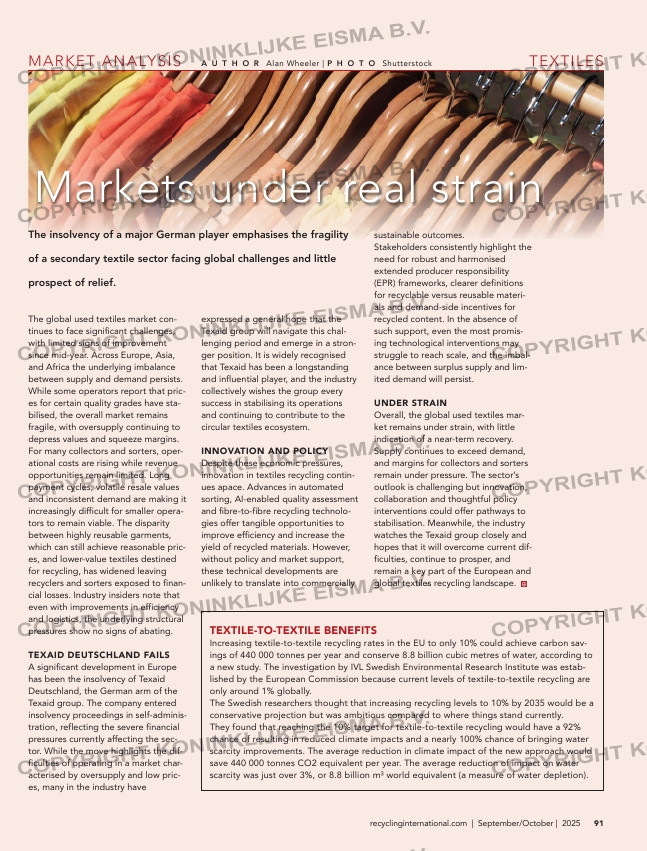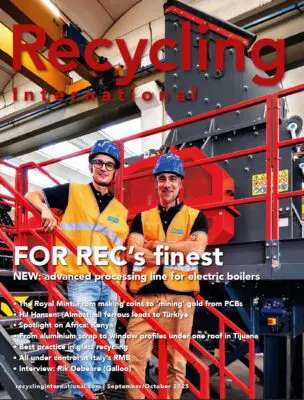Page 99 from: Recycling International September/October 2025

TEXTILESMARKET ANALYSIS
Markets under real strain
The insolvency of a major German player emphasises the fragility
of a secondary textile sector facing global challenges and little
prospect of relief.
91recyclinginternational.com | September/October | 2025
TEXTILE-TO-TEXTILE BENEFITS
Increasing textile-to-textile recycling rates in the EU to only 10% could achieve carbon sav-
ings of 440 000 tonnes per year and conserve 8.8 billion cubic metres of water, according to
a new study. The investigation by IVL Swedish Environmental Research Institute was estab-
lished by the European Commission because current levels of textile-to-textile recycling are
only around 1% globally.
The Swedish researchers thought that increasing recycling levels to 10% by 2035 would be a
conservative projection but was ambitious compared to where things stand currently.
They found that reaching the 10% target for textile-to-textile recycling would have a 92%
chance of resulting in reduced climate impacts and a nearly 100% chance of bringing water
scarcity improvements. The average reduction in climate impact of the new approach would
save 440 000 tonnes CO2 equivalent per year. The average reduction of impact on water
scarcity was just over 3%, or 8.8 billion m³ world equivalent (a measure of water depletion).
The global used textiles market con-
tinues to face significant challenges,
with limited signs of improvement
since mid-year. Across Europe, Asia,
and Africa the underlying imbalance
between supply and demand persists.
While some operators report that pric-
es for certain quality grades have sta-
bilised, the overall market remains
fragile, with oversupply continuing to
depress values and squeeze margins.
For many collectors and sorters, oper-
ational costs are rising while revenue
opportunities remain limited. Long
payment cycles, volatile resale values
and inconsistent demand are making it
increasingly difficult for smaller opera-
tors to remain viable. The disparity
between highly reusable garments,
which can still achieve reasonable pric-
es, and lower-value textiles destined
for recycling, has widened leaving
recyclers and sorters exposed to finan-
cial losses. Industry insiders note that
even with improvements in efficiency
and logistics, the underlying structural
pressures show no signs of abating.
TEXAID DEUTSCHLAND FAILS
A significant development in Europe
has been the insolvency of Texaid
Deutschland, the German arm of the
Texaid group. The company entered
insolvency proceedings in self-adminis-
tration, reflecting the severe financial
pressures currently affecting the sec-
tor. While the move highlights the dif-
ficulties of operating in a market char-
acterised by oversupply and low pric-
es, many in the industry have
expressed a general hope that the
Texaid group will navigate this chal-
lenging period and emerge in a stron-
ger position. It is widely recognised
that Texaid has been a longstanding
and influential player, and the industry
collectively wishes the group every
success in stabilising its operations
and continuing to contribute to the
circular textiles ecosystem.
INNOVATION AND POLICY
Despite these economic pressures,
innovation in textiles recycling contin-
ues apace. Advances in automated
sorting, AI-enabled quality assessment
and fibre-to-fibre recycling technolo-
gies offer tangible opportunities to
improve efficiency and increase the
yield of recycled materials. However,
without policy and market support,
these technical developments are
unlikely to translate into commercially
sustainable outcomes.
Stakeholders consistently highlight the
need for robust and harmonised
extended producer responsibility
(EPR) frameworks, clearer definitions
for recyclable versus reusable materi-
als and demand-side incentives for
recycled content. In the absence of
such support, even the most promis-
ing technological interventions may
struggle to reach scale, and the imbal-
ance between surplus supply and lim-
ited demand will persist.
UNDER STRAIN
Overall, the global used textiles mar-
ket remains under strain, with little
indication of a near-term recovery.
Supply continues to exceed demand,
and margins for collectors and sorters
remain under pressure. The sector’s
outlook is challenging but innovation,
collaboration and thoughtful policy
interventions could offer pathways to
stabilisation. Meanwhile, the industry
watches the Texaid group closely and
hopes that it will overcome current dif-
ficulties, continue to prosper, and
remain a key part of the European and
global textiles recycling landscape.
A U T H O R Alan Wheeler | P H O T O Shutterstock
91_matextiles.indd 91 09-09-2025 14:35



